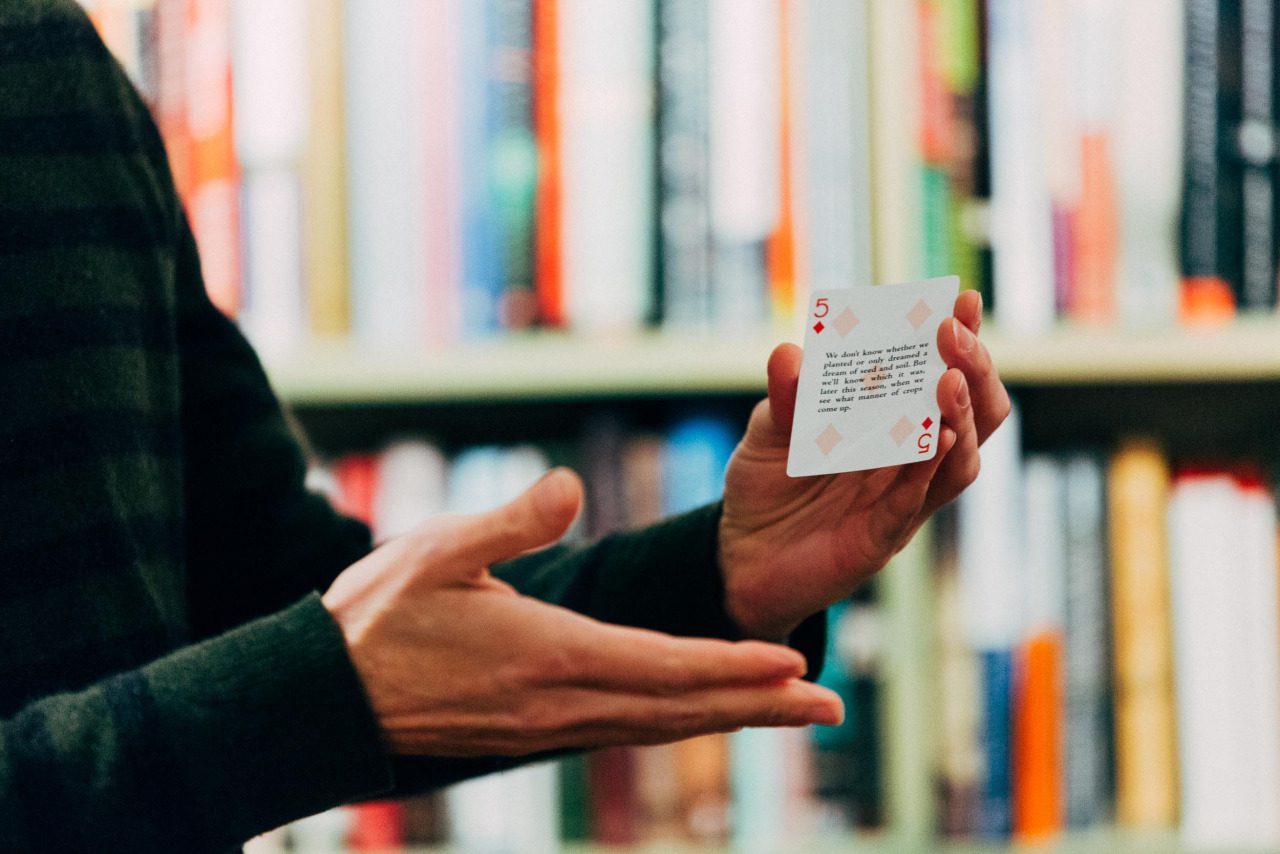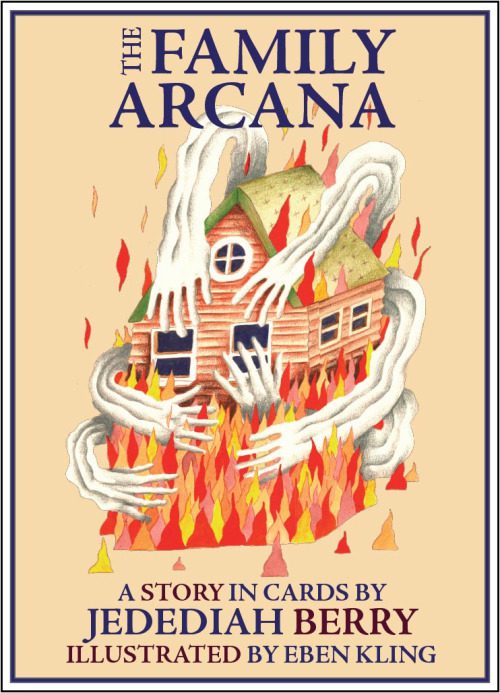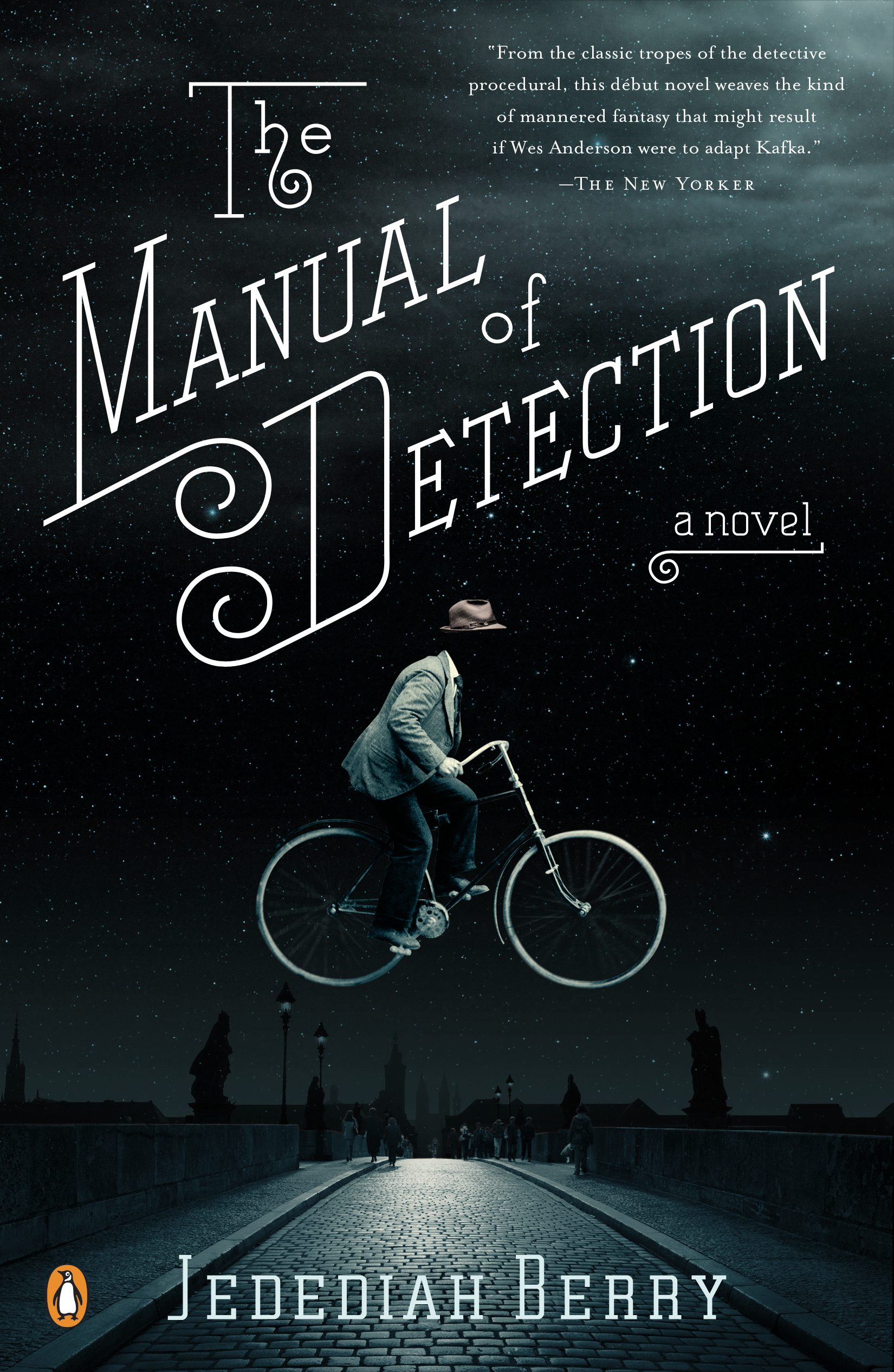Jedediah Berry is a writer who considers form a liberating constraint. His recent fiction has experimented with interactive forms, both physical and electronic. In 2015 with Emily Houk, he cofounded Ninepin Press, which publishes “stories in strange shapes.”
Ninepin’s inaugural publication was Berry’s “The Family Arcana,” a story published as a series of passages printed on a deck of playing cards, which can be arranged however a reader chooses. It’s told from the point of view of a large haunted family that wants to save its farmhouse from the bank people, who want to repossess the property. More recently, he used Twitter’s polling feature to write “Untine,” a crowd-sourced Choose Your Own Adventure-style story about a girl who is sent on a mission by an owl baron to untine the tined forest, and wanders into a carnival staffed by talking animals. His work has a surreal, gothic quality and a distinct, understated aesthetic that imbues his stories with a haunting and mysterious quality that is uniquely Berry’s.
I talked to Berry over email about interactivity in fiction, the various forms a story can take, and his goals in founding his own press.
***
The Rumpus: Your recent story, “Untine,” is made of passages readers voted on in Twitter polls, a sort of crowd-sourced Choose Your Own Adventure story. What made you want to write a story in that format, and what sorts of freedoms and constraints came with the format?
Jedediah Berry: I grew up reading Choose Your Own Adventure-style books, playing computer adventure games, and designing and playing role-playing games with my friends. These were some of my first experiences with storytelling and with fiction. When I saw Twitter’s new poll feature, using it to tell a story seemed like the natural thing to do. Cortázar talked about literature as a form of game-playing, and I wanted to evoke that sort of serious play with “Untine.”
 But I began the story on a whim. I was sitting on my mother’s back porch on a weirdly warm November day, looking down into the woods behind her house. My mom was dealing with a serious health issue, and I was there to help however I could. I was feeling—as I often am in the small Hudson Valley town in which I grew up—strongly connected to the place and isolated at the same time, and those feelings were heightened by the circumstances. Looking back, I think the story was a way to embrace that time and that landscape, while also giving myself a way to reach beyond the borders of where I was sitting just then, in terms of community but also in terms of myth-making.
But I began the story on a whim. I was sitting on my mother’s back porch on a weirdly warm November day, looking down into the woods behind her house. My mom was dealing with a serious health issue, and I was there to help however I could. I was feeling—as I often am in the small Hudson Valley town in which I grew up—strongly connected to the place and isolated at the same time, and those feelings were heightened by the circumstances. Looking back, I think the story was a way to embrace that time and that landscape, while also giving myself a way to reach beyond the borders of where I was sitting just then, in terms of community but also in terms of myth-making.
It was a strange process, drafting a story in public while leaving more than one possibility open at the end of every line. I felt great freedom in terms of plot and structure. I didn’t know where the story was going and I could never plan very far ahead. Where I felt some constraints was on the level of the sentence. I became highly conscious of how much I value the rhythm of the lines, because the lines would often span the gap between one update and the next. Another limitation was baked into Twitter’s polling format, in that each poll option is limited to twenty characters. I wanted every choice to be interesting, and it was often a challenge to fit something compelling into so small a space.
Rumpus: You’ve said that the story experiment lasted longer than you expected it to. When you say you could never plan very far ahead, how far ahead do you mean? Did you have much sense of direction in mind, or did the polls dictate more of the direction to you?
Berry: In general, when writing fiction, I look for moments when the story surprises me. When the characters do something I don’t expect, or when the plot veers away from my outline (assuming I have an outline). I try to embrace those surprises, because they often turn out to be right for the work. I think that unexpected turns in the writing process arise from some deeper, wiser perspective to which we’re only occasionally granted access.
With “Untine,” I used the polls as a way to constantly disrupt the writing and to keep myself on my toes. Some broader aspects of the story did become apparent eventually. I knew about halfway through, for example, that I wanted the protagonist’s destination to be haunted by the unchosen options from earlier polls. And I still had a good deal of control throughout, in the sense that I wrote every word, and that I never introduced an option which I wouldn’t be willing to pursue. It’s just that some of those options weren’t based on my first instinct, so the story turned out to be a stranger beast than those I’m usually shepherding, with first and second guesses, revisions and rejected notions all loping along together.
Rumpus: You said on Twitter, “If I have my way, [“Untine”] will evolve further, and the print edition will include new material as well.” Can you talk about your plans for the future of the story?
 Berry: My hope is that any print edition will translate what happened on Twitter into a new, related work that captures the same feeling of branching narratives and nested multiplicity. Strangely, this may also lead to an electronic, interactive adaptation comprised of the text from the original story along with material derived from the unchosen paths. I’m still working out the details, but it’s safe to say that these new iterations of the story—whatever form they end up taking—will feature characters who were mentioned only in passing in the Twitter version. I still want to know who the Advice Witch and the Ragged Hunter are, for example, and hopefully others do, too.
Berry: My hope is that any print edition will translate what happened on Twitter into a new, related work that captures the same feeling of branching narratives and nested multiplicity. Strangely, this may also lead to an electronic, interactive adaptation comprised of the text from the original story along with material derived from the unchosen paths. I’m still working out the details, but it’s safe to say that these new iterations of the story—whatever form they end up taking—will feature characters who were mentioned only in passing in the Twitter version. I still want to know who the Advice Witch and the Ragged Hunter are, for example, and hopefully others do, too.
Rumpus: Your recent work seems to be concerned with the role of the reader. It asks the reader to participate in the story instead of being a passive spectator. Your story “The Family Arcana” was published as a deck of playing cards. What sorts of story-effects were you setting out to achieve with the playing card format, and when did you know that format was right for the story?
Berry: Seeing the finished work, I imagine “The Family Arcana” must look like something that began with a concept—an interactive story packaged as a playing card deck—and that everything else followed in the wake of that idea. But the truth is, the story began as many of my stories do, with an insistent voice and an odd pile of imagery in need of sorting. In this case, the voice woke me in the middle of the night, and the pile was a great unwieldy junk heap. I grabbed a stack of index cards and started writing.
The story felt immediately huge, so I limited each episode to one side of a card. That form quickly felt essential to the telling of the tale, which is about this fragmented family with impossibly numerous children in an old, crumbling farmhouse. The bank people are trying to take the land, and the children are telling the story of their family with a kind of demented glee. I wrote the sections as they came to me, which meant keeping a handful of index cards in my jacket pocket for years. The world of that story became a place to which I could slip away in almost any circumstances.
I had maybe two dozen cards when I realized that I needed to set myself some kind limit. Going for a poker deck of fifty-two felt right for the scope of the thing, and it also felt true to the setting. I knew by then that I wanted the reader to construct the story from these various episodes however they wanted. Making it a poker deck hopefully emphasizes the playful quality of the project. In the end, I was able to work with the United States Playing Card Company on this. The layout was built on their Bicycle deck files, and manufactured on the same machines. That was a real joy for me.
You asked about story effects. I’d say that when working with a variable structure like this one—recombinatory is the word Umberto Eco uses—echoes and recurring elements are especially important. My hope is for certain patterns to emerge, and for readers to create the story for themselves using certain key images as signposts. The same thing might be said of most any story, of course, but here the reader’s collaborative role is made overt. As with other recombinatory works, including Lily Hoang’s Changing (modeled after the I Ching) and B.S. Johnson’s The Unfortunates (published as a set of boxed, modular chapters), the format simply brings the role of the reader—which ideally should always be active—to the fore.
Rumpus: There is also a supplementary pack for the story that includes additional cards, instructions for a four-player game, and other “curiosities,” according to Ninepin Press’s website. Can you talk about how the supplementary pack came to be and how these curiosities and the four-player game enhance the story?
 Berry: Yes! This was a lot of fun to put together. Eben Kling, the artist who did the illustrations for the story, had so much material, and we wanted to find a way to include it all. So I ended up designing a card game—it’s an old-fashioned partners trick-taking game—to incorporate some of that art. Of course the cards may be used to play any standard card game, but I wanted a game connected to the major themes of the story. So it’s the family versus the bank people, vying for control of the house using a bit of trickery and strategy, and the game doubles as another way to read the cards.
Berry: Yes! This was a lot of fun to put together. Eben Kling, the artist who did the illustrations for the story, had so much material, and we wanted to find a way to include it all. So I ended up designing a card game—it’s an old-fashioned partners trick-taking game—to incorporate some of that art. Of course the cards may be used to play any standard card game, but I wanted a game connected to the major themes of the story. So it’s the family versus the bank people, vying for control of the house using a bit of trickery and strategy, and the game doubles as another way to read the cards.
This also gave us a chance to expand the world of the story beyond the text itself. Emily Houk, my co-editor at Ninepin Press, wrote a series of “curiosities,” basically cards containing lists of wonderfully weird stuff to fill out the setting. Then she and our friend Michael Gundlach—a musician, artist, and chef—created some recipes for the food that appears in the story. All this felt much in the collaborative spirit of the story’s structure, and it expanded even into an instrumental soundtrack recorded by one of my favorite musical outfits, The Suitcase Junket. All this lends the story a life far beyond what I’d imagined.
Rumpus: Ninepin Press has published two stories in cards, and its website expresses a desire to “create beautiful objects.” When you and Emily Houk started the press, what did you see it becoming? What’s the story behind Ninepin Press?
Berry: The short version is that we created Ninepin Press to publish new works of fiction and poetry in unusual formats. What exactly we mean by unusual is still evolving, and I expect it to continue evolving as we publish work by more writers.
I think of it this way. A lot of fascinating work is obviously being done with electronic texts these days in terms of interactivity, branching narratives, melding of various media, and so on. For Ninepin, we’d like to capture some of these innovations in analog or even downright old-fashioned forms. Our hope is to attract writers and readers interested in the expanding possibilities of how form and content intersect.
Or to put it another way, we want the text and we want the object, and we want them living together in unexpected and exciting circumstances.
Rumpus: You’ve worked with both electronic and physical forms. What does a story-as-object offer that a story in electronic form doesn’t?
Berry: In my novel The Manual of Detection, the detective character is in possession of a guidebook called The Manual of Detection. And at one point in the novel, another character instructs the protagonist to read a specific page of the guidebook. Some readers have picked up on the fact that turning to the corresponding page of the novel will reveal the relevant passage from the guidebook.
 Pulling this off took some special arrangements. I worked closely with the designers to make sure that we had the page number correct after layout was complete. And while all this was intended as a bit of fun, there’s also some serious thinking behind it. The novel is concerned in part with how we build our understanding of the world and of one another through language, through the collection of evidence and clues, in both the specific and broader senses of these words. So the page number trick was one way of linking the reader’s experience to the protagonist’s. They have their hands on the same book at the same time, and they’re puzzling it out together.
Pulling this off took some special arrangements. I worked closely with the designers to make sure that we had the page number correct after layout was complete. And while all this was intended as a bit of fun, there’s also some serious thinking behind it. The novel is concerned in part with how we build our understanding of the world and of one another through language, through the collection of evidence and clues, in both the specific and broader senses of these words. So the page number trick was one way of linking the reader’s experience to the protagonist’s. They have their hands on the same book at the same time, and they’re puzzling it out together.
It didn’t occur to me until later that this gesture would be lost in most e-book formats, in which there are no static page numbers. A hyperlink might have worked, but this would have taken away all the subtlety. So here is one advantage I see with the physical object. Space for the quiet gesture which encourages an active sort of thinking on the part of the reader, and which rewards adventurousness accordingly. It’s a subtle drawing in, a slightly parted curtain.
While I know that quiet gestures are possible in electronic formats, the opposite is more readily available. Layering of text with image and sound, active links, the interpretation of clicks, taps, and swipes. This brighter, louder class of responsiveness is part of what makes electronic texts so alluring and so powerful. These days, what most excites me about electronic forms is the feeling that we’re commandeering tools meant for other, more mundane purposes and putting them to work on behalf of storytelling. It feels subversive and a little dangerous. This was part of my thinking with that Twitter story, of course, and you see it done at most every level with some of the more innovative writers of interactive fiction working today, folks like Emily Short, A. Johanna DeNiro, and Porpentine Charity Heartscape.
To be clear, I don’t feel that one form, electronic or physical, is superior to the other, only that each presents different possibilities. Literature is an adaptable beast. It can live and thrive in most any environment.
Rumpus: What projects are you working on now?
Berry: The biggest project before me is the completion of my new novel. The working title is The Something Tree, and it involves trains, ghosts, monsters, a committee of namers, and a traveling show. It’s inspired in part by the animated films of Hayao Miyazaki, as well as various works of spy fiction.
And there are a dozen smaller projects always clamoring for my attention. I’ve just finished a new story with Emily Houk, a long planned collaboration called “Hansel, Gretel, Grendel.” I have ideas sketched out for several more interactive works to be written with Twine, an excellent tool for creating nonlinear fiction. And, let’s see, there’s the series of sword and sorcery stories about a barbarian with a haunted left eyeball, a collaboration with writer and visual artist Mira Bartók, a novella that follows the events of The Manual of Detection. I tell myself that the fact I can’t keep up with all the projects I’d like to undertake is a good thing. A bit of a labyrinth, but I’m finding my way.
***
Author photograph © Tom Eberhardt-Smith.




